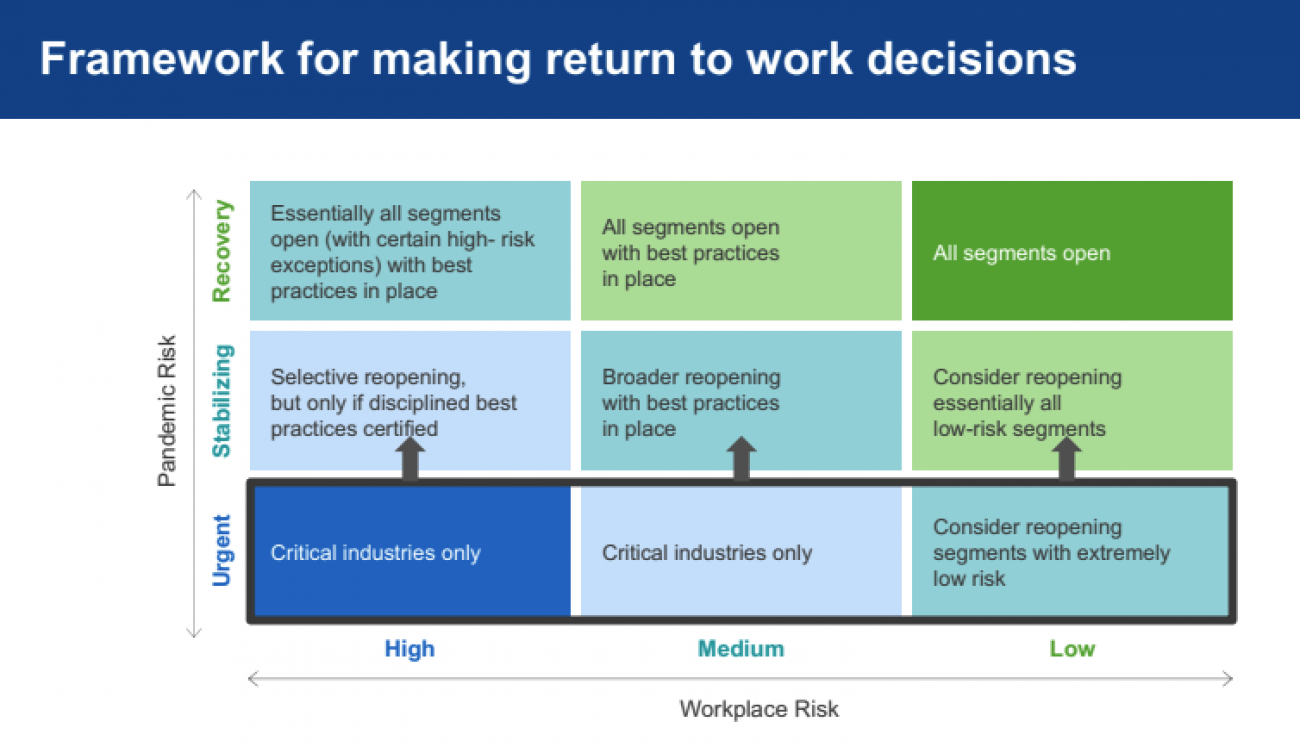Gov. Whitmer to restart Michigan economy by regions, types of workplaces

May 7 update: Michigan stay-at-home order extended to May 28
April 30 update: Whitmer extends Michigan emergency to May 28, as GOP threatens lawsuit
April 29 update: Michigan Gov. Whitmer to reopen construction industry May 7
LANSING — Michigan workplaces that reopen in coming months won’t look like the ones that employees remember before the coronavirus pandemic, Gov. Gretchen Whitmer and her advisers made clear Monday.
“Masks will be ubiquitous in almost every workplace in Michigan,” said DTE Energy Chairman Gerry Anderson, co-chair of a 29-member “economic recovery council” that is helping Whitmer develop plans to reopen businesses despite the ongoing coronavirus pandemic.
“Gloves and face shields will be in widespread use as well,” he said.
- Michigan Gov. Gretchen Whitmer wants 28-day extension of emergency powers
- The latest: Michigan coronavirus map, curve, chart, updated COVID-19 news
- Michigan’s latest stay-home order to allow landscaping, boating and golf
- What Gov. Gretchen Whitmer’s stay-at-home executive order means to Michigan
In a news conference that previewed how Whitmer would restart the economy, the governor didn’t announce many details of her new “MI Safe Start” plan, which are expected to come later this week.
Instead, Whitmer laid out underlying data the state will use to phase in reopenings across eight regions and nine workplace types, depending on COVID-19 case counts and the risk for continued spread.
The process could begin in the next week or two with residential and commercial construction firms and others that work outside, said Whitmer, who on Friday relaxed restrictions for landscapers and plant nurseries while extending her stay-at-home order through May 15.
The state is also taking a “hard look” at the industrial manufacturing sector and when facilities like auto plants can reopen, she told reporters.
“I will be guided by the data, not artificial timelines,” Whitmer said in a briefing at the Romney Building in downtown Lansing. “If we move forward and everything looks OK for a few weeks, we can look to expand it.”


Whitmer’s economic advisory council, co-chaired by retired Henry Ford Health System CEO Nancy Schlichting, includes business, health care and labor leaders who have developed plans over the past month in consultation with experts at the University of Michigan.
Decisions will be based, in part, on geography. Advisers have divided the state into eight regions based on employee travel patterns and the location of health care facilities. Risk in each region will be assessed based on COVID-19 case counts, health care capacity and ability to track contacts.
“This is really important, because the nature of hospital systems like my own and their capacity to deal with the COVID-19 outbreak varies significantly across regions across the state,” said Wright Lassiter III, current president and CEO of the Henry Ford Health System.
Decisions will also be made on job type. Whitmer’s advisory team has identified nine job categories, ranging from offices to industrial manufacturing plants, and is working with the University of Michigan to develop risk scores for each.
Risk factors include worker interactions (how often do employees interact with each other, the public or use shared tools?) workplace characteristics (do employees work indoors or outdoors?) and worker type (what are employee demographics and transit options?).
The advisory team is developing a list of best practices for each workplace type, Anderson said. Their recommendations, including what type of personal protection equipment should be provided to employees, is being reviewed by U-M occupational experts.
Companies can reduce their risk score by adopting new protocols, including access controls, on-site temperature checks, restrictions on common spaces such as break rooms, frequent disinfection, personal protection equipment and facility-specific contact tracing and isolation procedures, he added.
“The more urgent the pandemic risk and the more risky the workplace, the more cautious we’re going to be to reopen,” Anderson said.
The Monday preview came as Republican leaders of the Michigan Legislature continue to urge Whitmer to relax business restrictions in light of the economic fallout of the coronavirus pandemic, which has killed at least 3,407 residents, as of Monday afternoon.
GOP leaders have suggested the Legislature may not expand Whitmer’s emergency declaration, which is set to expire Friday, without additional changes.

That will “depend on how conversations go” with both Whitmer and President Donald Trump, House Speaker Lee Chatfield said earlier Monday in an interview with Sinclair Broadcast Group.
The state must continue to take the pandemic “seriously yet be more reasonable in our approach,” said Chatfield, R-Levering. “Michigan still has some very important steps we need to take before we extend this as a Legislature."
Whitmer contends she can continue taking emergency actions under a 1945 law that does not require legislative extensions. But that law does not include liability protections for public health workers, according to Whitmer, who is requesting a 28-day extension.
Earlier Monday, Republican Ohio Gov. Mike DeWine unveiled a plan to reopen manufacturing, distribution, construction, retail businesses and offices in his state over the next two weeks.
Ohio businesses that can reopen must adopt social distancing policies and require face coverings for all employees, clients and customers. Schools, restaurant dining rooms, hair salons, entertainment venues and gyms will remain closed for the time being.
DeWine rejected calls for a regional approach to ease restrictions more in parts of Ohio with fewer cases. His new order will apply statewide.
Whitmer is in regular communication with DeWine and other Midwest governors but has rebuffed Michigan GOP requests to adopt a more flexible federal definition of “essential worker” already in use by Ohio.
While Michigan’s coronavirus curve has flattened, Whitmer noted that, earlier this month, the state had the third highest number of cases in the country despite having only the 10th largest population.
“Doing what everybody else was doing was not going to be good enough,” she said.
RESOURCES:
- Hey, Michigan, here’s how to make a face mask to fight coronavirus
- Michigan coronavirus dashboard: cases, deaths and maps
- Michigan families can get food, cash, internet during coronavirus crisis
- How to give blood in Michigan during the coronavirus crisis
- 10 ways you can help Michigan hospital workers right now
- Michigan coronavirus Q&A: Reader questions answered
- How to apply for Michigan unemployment benefits amid coronavirus crisis
See what new members are saying about why they donated to Bridge Michigan:
- “In order for this information to be accurate and unbiased it must be underwritten by its readers, not by special interests.” - Larry S.
- “Not many other media sources report on the topics Bridge does.” - Susan B.
- “Your journalism is outstanding and rare these days.” - Mark S.
If you want to ensure the future of nonpartisan, nonprofit Michigan journalism, please become a member today. You, too, will be asked why you donated and maybe we'll feature your quote next time!




